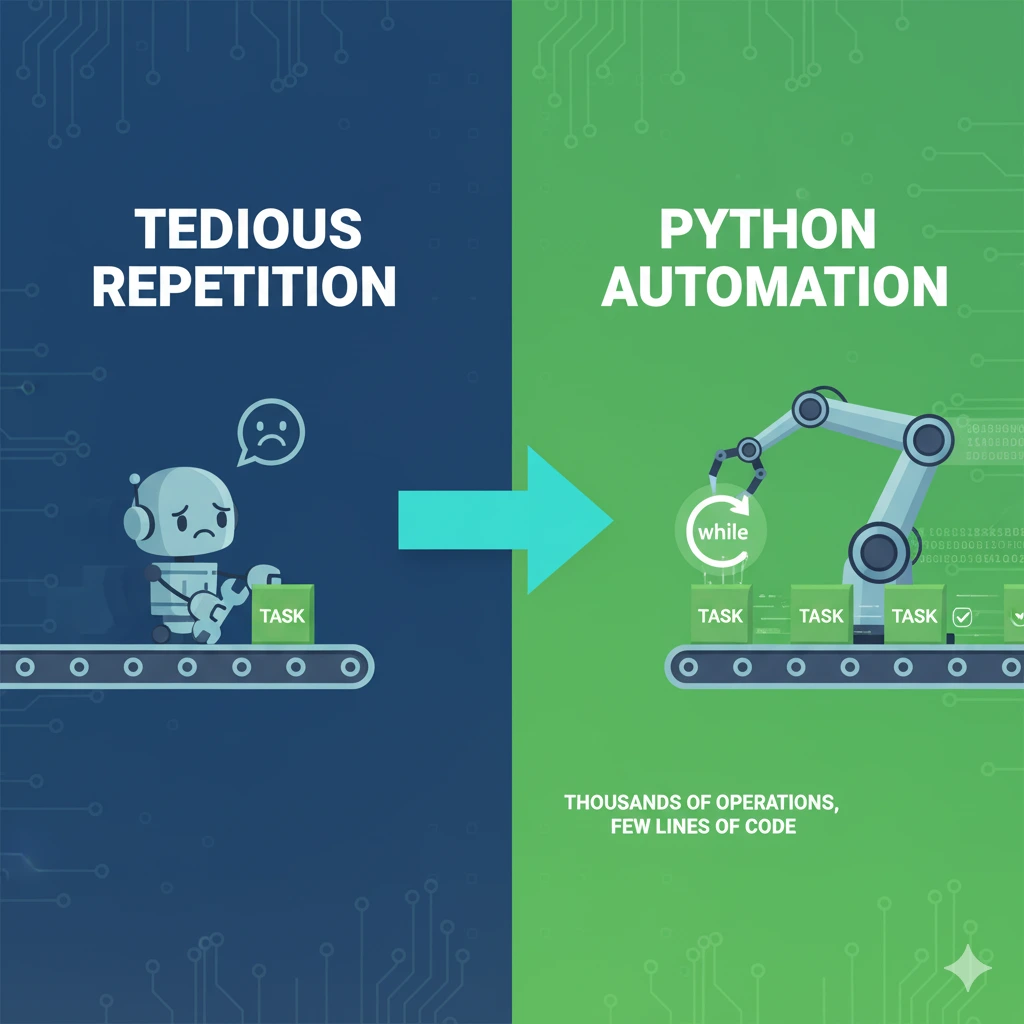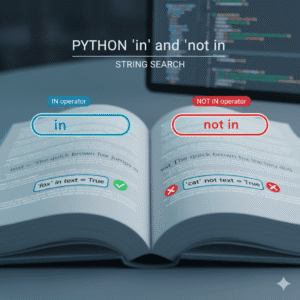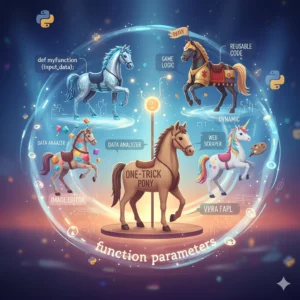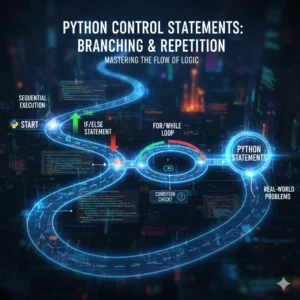Have you ever found yourself writing the same line of code over and over again? Maybe you needed to process hundreds of student grades, generate multiplication tables, or simply print “Hello World” multiple times. If you’ve been copying and pasting the same code repeatedly, there’s a better way!

Python loops are here to rescue you from tedious repetition. In this guide, you’ll master the while loop – one of Python’s most powerful tools for automating repetitive tasks. By the end, you’ll be able to write efficient code that can handle thousands of operations with just a few lines. Let’s dive in!
What Are Loops in Python?
Loops are programming constructs that allow you to execute a block of code multiple times. Think of them like your favorite kitchen appliance – a food processor. You don’t chop each vegetable individually; you put them all in the processor and let it do the repetitive work for you.
Similarly, loops handle repetitive tasks in programming. Instead of writing the same code 10, 100, or 1000 times, you write it once and tell Python how many times to repeat it.
Python offers two main types of loops:
- while loops (what we’re covering today)
- for loops (covered in future lessons)
Understanding the While Loop Syntax
The while loop continues executing as long as a certain condition remains true. Here’s the basic structure:
while condition:
# Code to execute repeatedly
# This code runs as long as condition is TrueLet’s break this down:
whileis the keyword that starts the loopconditionis any expression that can be evaluated as True or False- The colon (
:) indicates the start of the loop block - The indented code below is what gets repeated
Your First While Loop: Printing Hello World
Remember the problem we mentioned earlier? Printing “Hello World” multiple times? Here’s how a while loop solves it elegantly:
# Initialize a counter
counter = 1
# While loop condition
while counter <= 10:
print("Hello World")
# Increment the counter
counter = counter + 1
print("Loop finished!")When you run this code, you’ll see:
Hello World
Hello World
Hello World
Hello World
Hello World
Hello World
Hello World
Hello World
Hello World
Hello World
Loop finished!The Three Essential Parts of a While Loop
Every effective while loop has three crucial components:
1. Initialization
You need to set up a variable that controls how many times the loop runs. This is usually a counter.
counter = 1 # This is our initialization2. Condition
This is the test that determines whether the loop should continue running.
while counter <= 10: # This is our condition3. Increment/Decrement
You must change the counter variable inside the loop, or it will run forever!
counter = counter + 1 # This is our incrementHow the While Loop Actually Works
Let’s trace through our Hello World example step by step:
counter = 1– Counter starts at 1counter <= 10– Is 1 ≤ 10? Yes → Enter loopprint("Hello World")– First message printedcounter = counter + 1– Counter becomes 2counter <= 10– Is 2 ≤ 10? Yes → Enter loop again- …This continues until…
counter = 11– After the 10th iterationcounter <= 10– Is 11 ≤ 10? No → Exit loopprint("Loop finished!")– Final message
Practical Example: Multiplication Table Generator
Let’s create something more useful – a program that generates multiplication tables:
# Generate multiplication table for any number
number = 4
counter = 1
print(f"Multiplication table for {number}:")
while counter <= 10:
result = number * counter
print(f"{number} × {counter} = {result}")
counter += 1 # Shorthand for counter = counter + 1Output:
Multiplication table for 4:
4 × 1 = 4
4 × 2 = 8
4 × 3 = 12
4 × 4 = 16
4 × 5 = 20
4 × 6 = 24
4 × 7 = 28
4 × 8 = 32
4 × 9 = 36
4 × 10 = 40Avoiding Infinite Loops: A Critical Safety Tip
What happens if you forget to increment the counter? You get an infinite loop – the program runs forever!
# DANGER: Infinite loop!
counter = 1
while counter <= 10:
print("This will print forever!")
# Forgot to increment counter - BAD!Always ensure your loop has a way to eventually become false. If you accidentally create an infinite loop, you can usually stop it with Ctrl + C in most terminals.
Advanced While Loop Example: User Input Validation
While loops are perfect for validating user input. Here’s how you can ensure users enter valid data:
# Keep asking until we get valid input
age = -1 # Initialize with invalid value
while age < 0 or age > 120:
try:
age = int(input("Please enter your age (0-120): "))
if age < 0 or age > 120:
print("Please enter a valid age between 0 and 120.")
except ValueError:
print("That's not a valid number. Please try again.")
print(f"Thank you! Your age is {age}.")This loop continues prompting the user until they enter a reasonable age value.
Common While Loop Patterns
Countdown Pattern
# Countdown from 10 to 1
count = 10
while count > 0:
print(count)
count -= 1 # Decrement instead of increment
print("Blast off!")Sentinel Pattern (Stop with a special value)
# Process numbers until user enters 0
total = 0
number = 1 # Initialize with any non-zero value
while number != 0:
number = float(input("Enter a number (0 to stop): "))
total += number
print(f"The sum of all numbers is: {total}")Ready to Go from Basics to Pro?
You’ve taken your first steps into the powerful world of Python loops, but this is just the beginning. While loops are fundamental, but there’s so much more to explore – for loops, nested loops, loop control statements, and advanced iteration techniques.
If you’re serious about mastering Python, check out our pre-recorded python comprehensive video course.
Conclusion
Congratulations! You now understand how to use while loops to make your Python programs more efficient and powerful. You’ve learned:
- The three essential parts of every while loop (initialization, condition, increment)
- How to avoid infinite loops
- Practical applications like generating tables and validating input
- Common loop patterns you’ll use again and again
Remember, programming is like any other skill – you get better with practice. Try modifying the examples, create your own loops, and most importantly, have fun automating those repetitive tasks!
Common Questions About Python While Loops
Q: What’s the difference between while loops and for loops?
A: While loops continue based on a condition, while for loops iterate over a sequence (like a list or range). Use while loops when you don’t know how many iterations you’ll need in advance, and for loops when you’re processing known sequences.
Q: Can I nest while loops inside other while loops?
A: Yes! You can put while loops inside other while loops (called nested loops). This is useful for working with multi-dimensional data, but be careful as it can quickly become complex.
Q: How do I break out of a while loop early?
A: You can use the break statement to exit a loop immediately, or continue to skip to the next iteration. We’ll cover these in more advanced lessons.















